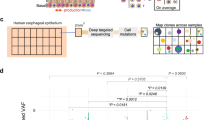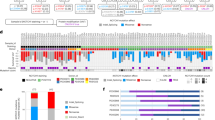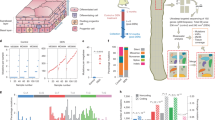Abstract
Multiple cancers may arise from within a clonal region of preneoplastic epithelium, a phenomenon termed ‘field change’1,2. However, it is not known how field change develops. Here we investigate this question using lineage tracing to track the behaviour of scattered single oesophageal epithelial progenitor cells expressing a mutation that inhibits the Notch signalling pathway. Notch is frequently subject to inactivating mutation in squamous cancers3,4,5,6. Quantitative analysis reveals that cell divisions that produce two differentiated daughters are absent from mutant progenitors. As a result, mutant clones are no longer lost by differentiation and become functionally immortal. Furthermore, mutant cells promote the differentiation of neighbouring wild-type cells, which are then lost from the tissue. These effects lead to clonal expansion, with mutant cells eventually replacing the entire epithelium. Notch inhibition in progenitors carrying p53 stabilizing mutations creates large confluent regions of doubly mutant epithelium. Field change is thus a consequence of imbalanced differentiation in individual progenitor cells.
This is a preview of subscription content, access via your institution
Access options
Subscribe to this journal
Receive 12 print issues and online access
$209.00 per year
only $17.42 per issue
Buy this article
- Purchase on Springer Link
- Instant access to full article PDF
Prices may be subject to local taxes which are calculated during checkout





Similar content being viewed by others
References
Slaughter, D. P., Southwick, H. W. & Smejkal, W. Field cancerization in oral stratified squamous epithelium; clinical implications of multicentric origin. Cancer 6, 963–968 (1953).
Braakhuis, B. J., Tabor, M. P., Kummer, J. A., Leemans, C. R. & Brakenhoff, R. H. A genetic explanation of Slaughter’s concept of field cancerization: evidence and clinical implications. Cancer Res. 63, 1727–1730 (2003).
Agrawal, N. et al. Exome sequencing of head and neck squamous cell carcinoma reveals inactivating mutations in NOTCH1. Science 333, 1154–1157 (2011).
Stransky, N. et al. The mutational landscape of head and neck squamous cell carcinoma. Science 333, 1157–1160 (2011).
Wang, N. J. et al. Loss-of-function mutations in Notch receptors in cutaneous and lung squamous cell carcinoma. Proc. Natl Acad. Sci. USA 108, 17761–17766 (2011).
Agrawal, N. et al. Comparative genomic analysis of esophageal adenocarcinoma and squamous cell carcinoma. Cancer Discov. 2, 899–905 (2012).
Doupe, D. P. et al. A single progenitor population switches behavior to maintain and repair esophageal epithelium. Science 337, 1091–1093 (2012).
Sakamoto, K. et al. Reduction of NOTCH1 expression pertains to maturation abnormalities of keratinocytes in squamous neoplasms. Lab Invest. 92, 688–702 (2012).
Sander, G. R. & Powell, B. C. Expression of notch receptors and ligands in the adult gut. J. Histochem. Cytochem. 52, 509–516 (2004).
Kopan, R. & Ilagan, M. X. The canonical Notch signaling pathway: unfolding the activation mechanism. Cell 137, 216–233 (2009).
Nicolas, M. et al. Notch1 functions as a tumor suppressor in mouse skin. Nat. Genet. 33, 416–421 (2003).
Demehri, S., Turkoz, A. & Kopan, R. Epidermal Notch1 loss promotes skin tumorigenesis by impacting the stromal microenvironment. Cancer Cell 16, 55–66 (2009).
Hu, B. et al. Multifocal epithelial tumors and field cancerization from loss of mesenchymal CSL signaling. Cell 149, 1207–1220 (2012).
Ohashi, S. et al. NOTCH1 and NOTCH3 coordinate esophageal squamous differentiation through a CSL-dependent transcriptional network. Gastroenterology (2010).
Tu, L. et al. Notch signaling is an important regulator of type 2 immunity. J. Exp. Med. 202, 1037–1042 (2005).
Proweller, A. et al. Impaired notch signaling promotes de novo squamous cell carcinoma formation. Cancer Res. 66, 7438–7444 (2006).
Naganuma, S. et al. Notch receptor inhibition reveals the importance of cyclin D1 and Wnt signaling in invasive esophageal squamous cell carcinoma. Am. J. Cancer Res. 2, 459–475 (2012).
Lee, J., Basak, J. M., Demehri, S. & Kopan, R. Bi-compartmental communication contributes to the opposite proliferative behavior of Notch1-deficient hair follicle and epidermal keratinocytes. Development 134, 2795–2806 (2007).
van Es, J. H. et al. Notch/gamma-secretase inhibition turns proliferative cells in intestinal crypts and adenomas into goblet cells. Nature 435, 959–963 (2005).
Lowell, S., Jones, P., Le Roux, I., Dunne, J. & Watt, F. M. Stimulation of human epidermal differentiation by delta-notch signalling at the boundaries of stem-cell clusters. Curr. Biol. 10, 491–500 (2000).
Demehri, S. et al. Elevated epidermal thymic stromal lymphopoietin levels establish an antitumor environment in the skin. Cancer Cell 22, 494–505 (2012).
Di Piazza, M., Nowell, C. S., Koch, U., Durham, A. D. & Radtke, F. Loss of cutaneous TSLP-dependent immune responses skews the balance of inflammation from tumor protective to tumor promoting. Cancer Cell 22, 479–493 (2012).
Watt, F. M., Jordan, P. W. & O’Neill, C. H. Cell shape controls terminal differentiation of human epidermal keratinocytes. Proc. Natl Acad. Sci. USA 85, 5576–5580 (1988).
Rubio, C. A., Liu, F. S., Chejfec, G. & Sveander, M. The induction of esophageal tumors in mice: dose and time dependency. In Vivo 1, 35–38 (1987).
Bennett, W. P. et al. Archival analysis of p53 genetic and protein alterations in Chinese esophageal cancer. Oncogene 6, 1779–1784 (1991).
Zhang, W., Remenyik, E., Zelterman, D., Brash, D. E. & Wikonkal, N. M. Escaping the stem cell compartment: sustained UVB exposure allows p53-mutant keratinocytes to colonize adjacent epidermal proliferating units without incurring additional mutations. Proc. Natl Acad. Sci. USA 98, 13948–13953 (2001).
Demehri, S. & Kopan, R. Notch signaling in bulge stem cells is not required for selection of hair follicle fate. Development 136, 891–896 (2009).
Burns, E. R., Scheving, L. E., Fawcett, D. F., Gibbs, W. M. & Galatzan, R. E. Circadian influence on the frequency of labeled mitoses method in the stratified squamous epithelium of the mouse esophagus and tongue. Anat. Rec. 184, 265–273 (1976).
Quante, M. et al. Bile acid and inflammation activate gastric cardia stem cells in a mouse model of Barrett-like metaplasia. Cancer Cell 21, 36–51 (2012).
van Es, J. H., de Geest, N., van de Born, M., Clevers, H. & Hassan, B. A. Intestinal stem cells lacking the Math1 tumour suppressor are refractory to Notch inhibitors. Nat. Commun. 1, 18 (2010).
Clayton, E. et al. A single type of progenitor cell maintains normal epidermis. Nature 446, 185–189 (2007).
Demehri, S., Morimoto, M., Holtzman, M. J. & Kopan, R. Skin-derived TSLP triggers progression from epidermal-barrier defects to asthma. PLoS Biol. 7, e1000067 (2009).
Acknowledgements
We thank Warren Pear (University of Pennsylvania) for the DNMaml mouse strain, E. Choolun, K. Murai, J. Fowler and the staff at ARES (Cambridge) for support and technical assistance and R. Kopan for informative discussions. We acknowledge the support of the MRC, the NC3Rs (National Centre for the Replacement, Refinement and Reduction of Animals in Research), the Wellcome Trust (grant numbers WT090334MA, P.H.J., and 098357/Z/12/Z, B.D.S.), a Deutsche Forschungsgemeinschaft Research Fellowship (P.G.) and European Union Marie Curie Fellowship PIEF-LIF-2007-220016 (M.P.A.).
Author information
Authors and Affiliations
Contributions
P.H.J. envisaged the project. M.P.A., P.G., B.D.S. and P.H.J. were involved with experimental design. M.P.A., A.W. and J.F. carried out experiments. P.G. and B.D.S. carried out quantitative analysis. M.P.A. and P.H.J. wrote the manuscript, P.G. and B.D.S. contributing quantitative sections.
Corresponding author
Ethics declarations
Competing interests
The authors declare no competing financial interests.
Integrated supplementary information
Supplementary Figure 1 Cell behaviour in normal mouse oesophageal epithelium.
a, Section of mouse oesophageal epithelium. Scale bar, 200 μm. Inset: Structure of epithelium. Proliferation is confined to the basal layer b, differentiating cells enter the suprabasal layers (sb), migrate to the tissue surface, and are then shed into the oesophageal lumen (l). Inset scale bar, 50 μm. b, Cell fate in basal layer of normal homeostatic mouse oesophageal epithelium. Progenitor cells (P, blue) divide at a rate of 1.9/week. Each division can have one of three outcomes: two progenitor daughters (PP), two differentiating daughters (red, DD) or one cell of each (PD). Differentiating cells stratify out of the basal layer (arrow) at a rate of 3.5/week. The outcome of a specific division is unpredictable but the probabilities of each outcome (shown as %) are balanced to achieve homeostasis across the progenitor population. c, Consequences of stochastic cell fate of normal progenitors for clonal survival. Two progenitor cells following the dynamics in b are illustrated. By chance, the progeny of left hand cell clone all differentiate due to a PD division followed by a DD division. Such events are frequent with 90% of clones being lost by differentiation within 3 months7. Progeny of the right hand cell undergo early PP and PD divisions, by the fourth generation the odds of all three progenitor cells undergoing DD division and the clone differentiating are 1 in 1,000. Normal progenitors generate few such persistent clones7. d, Tiled images showing OE wholemounts, immunostained for GFP (green), 1 year after clonal induction of DNM mice. Appearances shown are typical of 17 induced DNM mice and 6 control uninduced DNM mice, 1 year post induction. Control is age matched un-induced DNM animal. Dapi is blue, scale bar, 500 μm.
Supplementary Figure 2 Clone size distributions: data and fit to model.
a,b, Size distribution of clones categorized by the number of basal and suprabasal cells/clone, 7 days after induction. a, YFP control (n = 103 clones), b DNM clones (n = 300 clones), imaged from three mice per group in one experiment . Green bars are data from three-dimensional clone imaging, points indicate model predictions, error bars are 95% confidence intervals of the predictions of the models in Fig. 2g (DNM) and Supplementary Fig. 1b (YFP control) (Supplementary Note). c, Basal clone size distribution at 7 days post induction. Points are data, indicating the percentage of clones with a given number of basal cells in clones from YFP control (blue, n = 103 clones) or DNM induced mice (black, n = 300 clones). Solid lines show predictions of models shown in Fig. 2g (DNM) and Supplementary Fig. 1b (YFP controls), shading indicates 95% confidence intervals of the model predictions (Supplementary Note). d, Basal clone size distribution 15 days after induction of DNM mice using the best fit parameters shown in Fig. 2g. Data is shown in a logarithmic binning, where each bin grows by a factor of two from left to right, n = 60 clones imaged from three mice in one experiment, indicating the percentage of clones with a given number of basal cells. Solid line shows model prediction, shading indicates 95% confidence interval of model prediction (Supplementary Note). e, Full data set fitting of basal clone size distributions in DNM mice 10 days after induction (Supplementary Note). The resulting fit parameters were λ = 5.5/week, r = 0.065, γ = 0.85/week. Lines are model predictions, points show data and shading 95% confidence range of model predictions. f, Clonal area prediction over time (Supplementary Note) measurements of clonal areas in DNM induced mice are compared with model predictions. The best fit model parameters were used for this prediction. Taking into account the calculated labelling frequency of 1/526, for model extrapolation we assume that each basal cell corresponds to a total area fraction of 0.19%. g, Two parameter fit of total clone size distribution 10 days post induction (Supplementary Note). Data (black squares) together with model predictions of the simplified model from Supplementary Note, which has only two parameters λ and r (black line, shaded area is 95% confidence range). In this model cell loss is neglected (σ = 0) and cell fate is fully tilted (δ = 1). The parameters are λ = 5.4/week and r = 0.065 resulting from a maximum likelihood fit of this model.
Supplementary Figure 3 Expression of Sox9, Krt6 and Itgb4 in DNM and wild type cells.
Confocal images of cryosections of oesophageal epithelium in DNM mice 3 months post induction. Green is DNM, Blue, Dapi, Red is the basal cell marker Itga6 (which partners Itgb4 in the hemidesmosome) and white is Sox9 a,b, Krt6, c,d and Itgb4 e,f. Scale bar, 20 μm. Each image is typical of at least 8 sections from each of three mice in one experiment.
Supplementary Figure 4 Immune effects of clonal DNM induction.
a, Serum Tslp levels at 10 days, 3 months and 1 year following clonal induction of DNM mice (DNM) and in aged-matched un-induced controls. Data are from n = 5 mice (10d) and 3 mice (3m) per condition. At 1 year, n = 5 mice (control), 11 mice (DNM) and 8 mice (DNM-High). As a positive control, DNM animals were treated with high dose β napthoflavone and tamoxifen, to induce epidermal DNM expression (inset) which resulted in increased serum Tslp. **P < 0.01 by t test. Inset shows epidermal DNM expression in typical wholemounts of tail epidermis from DNM and DNM-High groups at 6 months post induction; Dapi is blue, DNM green, scale bar, 100 μm, images typical of 3 mice/group. b,c, Epithelial leukocytes are excluded from DNM epithelium. OE wholemounts were stained for the pan-leukocyte marker Cd45 (red) and the T lymphocyte marker Cd3 (white) in induced DNM mice and age-matched un-induced controls. DNM is green, Dapi blue, scale bars, 50 μm, except low magnification views 100 μm, images shown typical of at least 4 sections per mouse in 3 mice/group. b, Typical images from 6 months induced DNM mice and age-matched un-induced controls, note the exclusion of immune cells from the DNM mutant areas. c, Typical fields from control and DNM epithelium one year post induction. d, Number of Cd45 positive cells per field, one year post induction. At least 200 Cd45 positive cells were scored per condition. n = 3 mice per group in one experiment. *P < 0.05 by t test e, Epithelial Cd3:Cd45 ratio, one year post induction. At least 250 Cd45 positive cells were scored, n = 3 mice per group in one experiment. f, Leukocytes in oesophageal submucosa in six months induced DNM mice and age-matched un-induced controls. Cryosections were stained for the pan-leukocyte marker Cd45 (red) and DNM (green), Dapi is blue, scale bar, 20 μm. No significant difference in leukocyte density was observed, images shown typical of at least 4 sections per mouse in 3 mice/group. g, Oesophageal submucosal wholemounts stained for activated fibroblast marker α-smooth muscle actin (αSMA, red) in one year induced DNM mice and age-matched un-induced controls. Dapi is blue, scale bar, 20 μm. No αSMA staining was detected, images shown typical of at least 4 sections per mouse in 3 mice/group. h, Typical sections of epithelium in induced and age-matched uninduced control DNM mice 1 year post induction, stained for activated Caspase3 (red). UV irradiated sample is a positive control, exposed to ultraviolet radiation and maintained as explant culture, positive cells are indicated by arrowheads. No positive cells were detected in 10 sections/mouse from 3 DNM or 3 control mice. DNM is green and Dapi blue, scale bar, 20 μm.
Supplementary Figure 5 Representative lesions in uninduced and induced DNM mice subsequently treated with DEN.
a–d, Representative images of epithelial wholemounts showing typical tumours found in animals treated in protocol shown in Fig. 5i. a,b, DEN treated uninduced DNM controls (low level green is auto-fluorescence). c,d, induced DNM mice. DNM is stained green, Dapi is blue, scale bar, 200 μm.
Supplementary information
Supplementary Information
Supplementary Information (PDF 1610 kb)
Rights and permissions
About this article
Cite this article
Alcolea, M., Greulich, P., Wabik, A. et al. Differentiation imbalance in single oesophageal progenitor cells causes clonal immortalization and field change. Nat Cell Biol 16, 612–619 (2014). https://doi.org/10.1038/ncb2963
Received:
Accepted:
Published:
Issue Date:
DOI: https://doi.org/10.1038/ncb2963
This article is cited by
-
Bridging tissue repair and epithelial carcinogenesis: epigenetic memory and field cancerization
Cell Death & Differentiation (2024)
-
Tissue memory relies on stem cell priming in distal undamaged areas
Nature Cell Biology (2023)
-
Notch1 mutations drive clonal expansion in normal esophageal epithelium but impair tumor growth
Nature Genetics (2023)
-
Regenerative medicine: current research and perspective in pediatric surgery
Pediatric Surgery International (2023)
-
p53 mutation in normal esophagus promotes multiple stages of carcinogenesis but is constrained by clonal competition
Nature Communications (2022)



